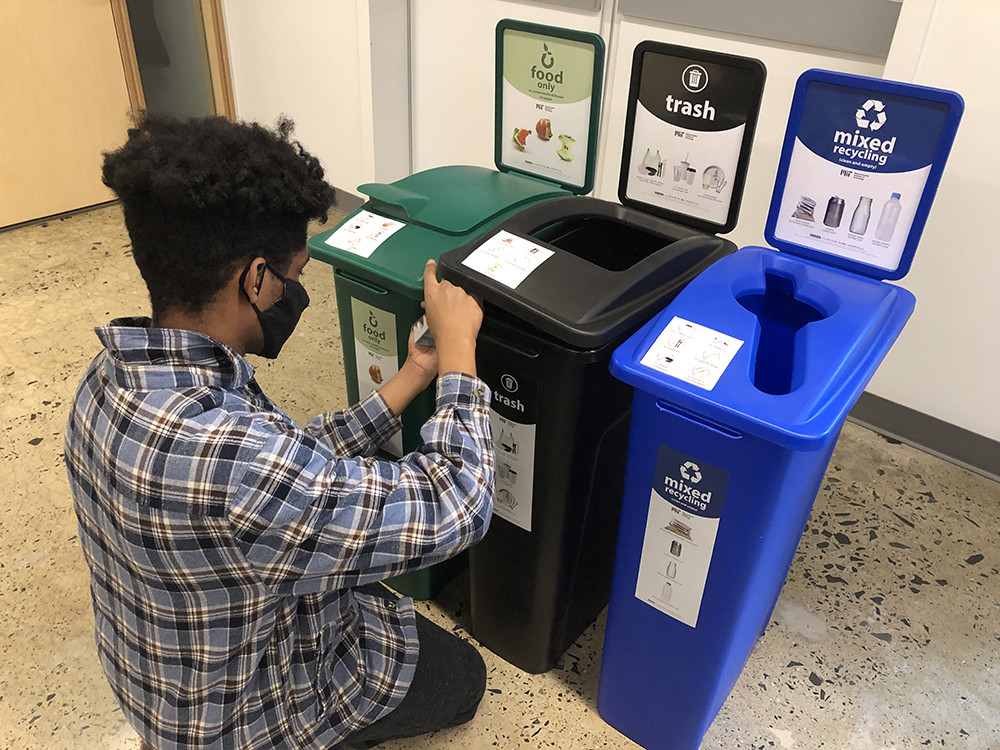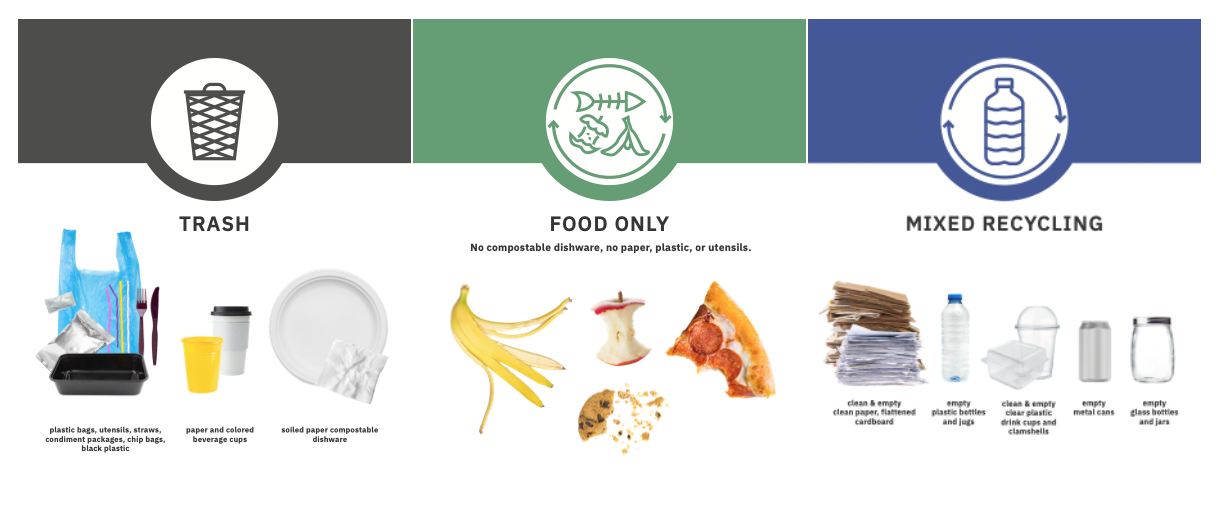Recycle Smart Massachusetts provides downloadable guides in the below languages:
MIT seeks to re-imagine its waste management systems and behaviors in order to safely eliminate waste generation and drive a circular flow of materials from inputs through outputs, procurement through disposal. The Office of Sustainability in partnership with the Department of Facilities and individual dorms, departments, labs, and centers is testing the implementation of new waste collection and education infrastructure. Below you will find the new Waste Wizard and FAQs related to locations that are using enhanced waste management systems of bins, labels, signs, and posters. As best practices are tested and demonstrated, MIT seeks to continue to expand the implementation of these systems across campus.
Unsure whether or not an item can be recycled, use the Waste Wizard (beta). Have other questions? Explore the FAQs or email us at zerowaste@mit.edu
The MIT Waste Wizard is currently in beta. You can help us build out the catalog to best fit the MIT campus. Did you search for an item and get no results? Let us know by filling out this short form and we will add it to the wizard.
Recycle Smart Massachusetts provides downloadable guides in the below languages:
Bin system with labels

Labels and wall signage

If you would like to download signage to print for your own area, visit the Resource Library or order signage through CopyTech.
Research has shown that centralized waste stations are better for decreasing waste stream contamination (i.e. placing the wrong material into the wrong bin such as a banana peel into the trash or recycling when it belongs in the FOOD ONLY) by encouraging people to use clearly labeled centralized bins in lieu of a single stream basket. This system encourages practices that can lead to healthier workplaces and generate waste materials that can be recycled and reprocessed rather than landfilled or incinerated. Furthermore, the reduction in overall number of bins enables safer occupational health for custodial teams who need to bend less frequently for collecting material from desk side bins. Even better, think of walking to throw away your trash or recycling as a chance to exercise and move around!
Peer institutions such as Emory, Brown, and many others have adopted this policy for these reasons.
Preventing food from entering the trash stream is one of the most effective changes people can make to fight climate change. When food is wasted, so is the energy, nutrients, and water that went into creating the food. Food waste placed in the trash usually ends up in landfills, which are the third-largest source of methane emissions in the United States. Approximately 60 percent of landfill methane emissions are from food waste. Methane, a potent greenhouse gas, is captured as a renewable power resource when food waste is placed in campus food waste bins.
Since campus waste audits find 35 percent of MIT’s trash is food waste, the more buildings, departments, labs, and centers that adopt centralized waste bins, the more methane our community can divert from atmospheric release.
The bin systems were chosen following a process that engaged stakeholders and experts to identify the best size, color, and system to impact behavior, and support a circular system. Each of the three-bin systems are arranged in the same order to create a uniform experience for sorting waste no matter the location in the buildings.
Additionally, free-standing station locations will be identified by visibility, accessibility, and traffic and tested during a trial period. Due to the ongoing uncertainty surrounding the pandemic and density of campus, this trial period is flexible. Feedback from each space based on the trial period will inform more permanent station locations. In addition to being color coded based on material accepted, each bin is equipped with signage that includes do’s and don’ts to help users know which bin fits their needs.
Like the bins, the labels and signage are the result of a collaborative process that engaged the Department of Facilities and MITOS. The labels reflect the items and language that best-fit activities on the MIT campus. The bin labels and signs are designed to minimize recycling and food waste stream contamination and respond to the needs of the community and items most likely to be used in these buildings.
Data is an essential part of decision making around bins, signage, and other tactics to design out waste from campus. Findings from waste audits conducted by Waste Watchers, MITOS, and our partners drove the decisions around bin style selection and also helped to identify what items most commonly contaminate recycle streams on campus. Those items are highlighted on signage as examples of what not to put in a certain bin.
All major campus waste streams (recycling, trash and food waste) are collected from bins by MIT Custodial Services or Residential Life housekeeping teams and taken by these teams to each building’s loading dock.
Recycling: Our recycling is picked up by our hauler, Casella, and sent to Save That Stuff and Casella Materials Recovery Facilities (MRFs) so that some materials are collected and made into different products. If you’re interested in learning more, you can watch this YouTube video.
Trash: Most of the trash is incinerated in a waste to energy facility or sent to transfer stations before being sent to landfills. Primary facilities include Wheelabrator Saugus in Saugus, MA- Waste to Energy (WTE), Brookline Transfer Station in Brookline, MA, and BFI Waste Systems Transfer Station in Roxbury, MA.
Food Waste: Food waste is sent to the Greater Lawrence Sanitary District (GLSD) to be recycled into clean energy using a process called Anaerobic Digestion. First, MIT sends its food waste to a facility in Charlestown, MA for initial processing where it is then sent to the GLSD facility in North Andover, MA. See this site for more information about where MIT sends its food waste: Food Waste Processing Facility.
There have been questions about whether this co-digestion process is more environmentally and economically efficient than traditional composting. A study initiated by the EPA has determined that anaerobic digestion at GLSD is a higher and better use for fighting climate change than traditional compost. Read about the EPA lifecycle assessment here.
MIT Material Matters is a data visualization that provides monthly waste totals for the major waste streams on campus. The visualizations are continuing to be updated as new data becomes available.
The new waste collection stations are now in place in multiple spaces and buildings across MIT's campus:
Other innovative features of this new system:
For spaces participating in the centralized bin program, desk-side bins have not been provided and will not be serviced by Custodial Services. Custodians will only service the centralized food waste, recycling, and trash bins. A new food waste collection service is now provided spaces utilizing centralized bin systems, in a continued pilot of MIT-provided food waste collection outside of a dining location. Centralized bins can limit contamination and support healthy habits, offering better pest management with fewer waste locations in the building.
If people find that the centralized waste bins are not located in convenient places, the bins are light and flexible in the event they do need to be re-positioned within the space. If a move of bins is needed, we strongly recommend that DLC-operational leadership is consulted so that the move works well for everyone in the space.
Desk-side bins are for self-servicing. Some folks may have brought their own desk-side bins. One can certainly keep desk side bins to hold waste materials temporarily until you are ready to bring your waste to a convenient waste collection stations for sorting. Please do not keep any food or food-soiled waste in a desk-side bin overnight in order to avoid pests and odor. You may also remove your desk side bin altogether if you wish.
If you have temporary or permanent mobility issues and need accommodation, please email us at binrequest@mit.edu
Design out waste at MIT means designing and testing strategies that reduce the generation of trash and increase the amount of clean material (i.e. paper goods, plastics, and food waste) that can be recycled and re-processed.
MIT seeks to reimagine its waste management systems and behaviors in order to safely eliminate waste generation and drive a circular flow of materials from inputs through outputs, and procurement through disposal. Transforming systems and individual behaviors can be challenging, especially where long-established systems and norms exist. As such, the “blank canvas” of spaces like Building E37 and E38 allows for an opportunity to test pilots, refine best practices, and innovate new solutions.
The test cases you see around the buildings are supported by data collected from previous pilots and studies around campus. For example, campus waste data collected and analyzed from numerous locations reveals significant levels of contamination of recycling, trash, and food waste streams. Newly occupied spaces provide the opportunity to evaluate practices, collect data, feedback insights to the community and demonstrate possibilities to mitigate this contamination which can then be scaled up for designing out waste throughout the MIT campus.